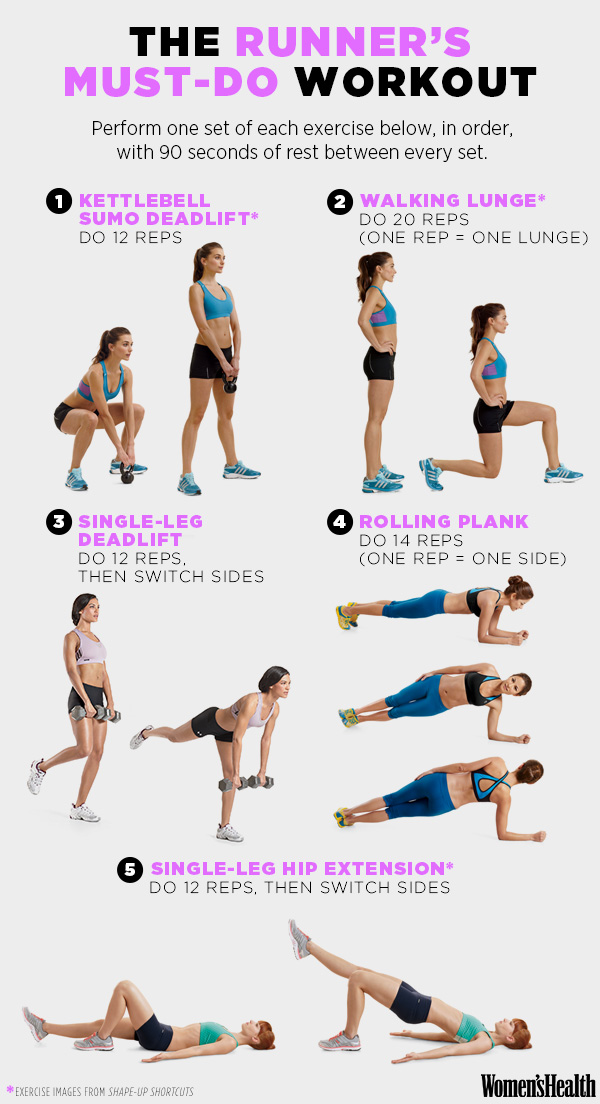By: Angela Joy
Most runners participate in only one form of exercise which is, you guessed it – running.
Doing the same form of exercise each day is not effective in properly strengthening the body’s muscles, improving performance and preventing injuries.
As a result, it is suggested that runners participate in a consistent resistance training program to properly strengthen their muscles and evenly distribute their weight.
Strength training will not only assist in preventing injuries, it will also increase speed, endurance, runner efficiency, balance and flexibility.

Why Strength Train?
As a runner it is easy to fall into the pattern of running the same route, for the same distance, for the same amount of time, day in and day out.
When we participate in the same consistent form of exercise our muscles are not being challenged.
Over time the body will acclimate to these activities and will not build strength or endurance.
Chief Science Officer at the American Council on Exercise Cedric Bryant reported that variety in an exercise routine allows the body to be physically challenged.
He concluded in an ACE article titled, “Why is it Important to Vary My Exercise Routine,” many of the body’s physiological systems, such as the muscular system, will adapt to an exercise program within approximately six to eight weeks.
He further stated that continuing to participate in the same form of exercise activities will cause the body to “reach a plateau because your body has adapted to the repetitive training stimulus.”
In an effort to prevent reaching a plateau it is not only beneficial to alternate between different types of workouts, but to also incorporate different styles, durations, equipment and intensities.

The Benefits of Strength Training
The muscles used during running must be properly strengthened, stretched and cared for in order to sustain your running ventures, reach performance goals and increase your running abilities.
Strength training will create strong muscles, prevent injury, improve speed and confidence, improve running efficiency, while also allowing the body to more effectively utilize each breath.
A Runner’s World Magazine article titled, “Strength Training for Runners” stated that if you want to “perform at your full potential” you need to take a comprehensive approach to your training – which includes flexibility, mobility, balance and strength training.

How to Strength Train
Strength training is defined by the American College of Sports Medicine (ACSM) as “a form of physical activity that is designed to improve muscular fitness by exercising a muscle or a muscle group against external resistance.”
Strength training activities can be accomplished through traditional free weights, body weight exercises, resistance machine exercises, elastic tubing, medicine balls, and even household items such as cans and jugs, the ACSM stated in a 2013 report on resistance training.
The ACSM recommends that a strength training program is performed a minimum of two non-consecutive days each week.
According to the ACSM, one standard strength training session should be made up of 8 to 10 different exercises that target all of the major muscle groups, and each exercise should be completed for a total of 8 to 12 repetitions.
Strength training workouts general target the chest, back, shoulders, bicep, triceps, abdomen, quadriceps and hamstring muscles.
Runners however tend to focus on specific areas of their body when participating in a strength training program.
According to Runner’s World Magazine runners should focus on strengthening three areas; the core, upper body and lower body.
Core muscles strengthen the abdominals and back. These muscles are the foundation of all movement. Therefore, a strong core create and support strong legs and arms.
Lower body muscles include the soleus, gastrocnemius, tibialis anterior, quadriceps and hamstring muscles.
These muscles create leg strength to withstand fast, long and difficult running ventures.
Upper body muscles include the shoulders, chest, biceps, and triceps. These muscles increase speed during running as the runner pumps their arms and proportionately balances their bodies.

Strength Training Exercises
A few examples of resistance training exercises to improve running ability, strength and performance include;
- Squats
- Lunges
- Plank
- Clamshells
- Bent-over row
- Side plank
- Lower body Russian twists
- Scorpion
- Back extension
- Hip bridge
- Jack knife
- Alternating shoulder press
- Deadlift

Accomplished American marathon runner Amby Burfoot has inspired millions of runner with his quote, “You have to want it, you have to plan for it, you have to fit it into a busy day, you have to be mentally tough, you have to use others to help you. The hard part isn’t getting your body in shape. The hard part is getting your mind in shape.”


March 15, 2016 at 5:18 pm
The Burfoot quote hit me where it feels! I know ALL of what you are writing but I just can not do it. I know I needthe strength but the distance from knowing to doing is like Grand Canyon.
LikeLiked by 1 person
March 16, 2016 at 12:24 pm
This is SO true. There are so many things in our life that we know we need or should do, but just can’t seem to find the time to do it.
If this is a priority to you then you will start to implement it into your routine. Know that it doesn’t have to be perfect and you can start by doing just a few exercises for 5-10 min! I know how daunting it may seem after running for hours – but it makes all the difference. Good luck 🙂 Thank you for reading!!!
-Angela Joy
LikeLiked by 1 person
March 15, 2016 at 11:19 pm
Great tips Angela – I also find by limiting my runs to once a week max it keeps me on my toes and challenged….
LikeLiked by 1 person
March 16, 2016 at 12:25 pm
I love that Laura! Thank you for sharing. The versatility is great!
Thank you for reading 🙂
-Angela Joy
LikeLiked by 1 person